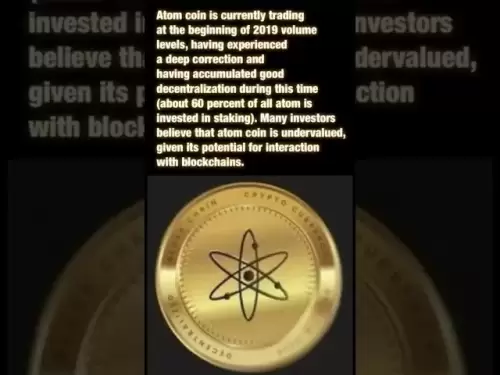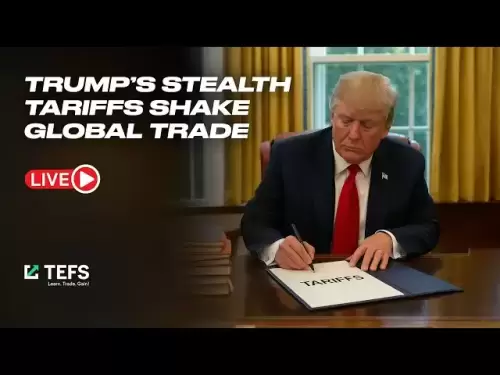-
 Bitcoin
Bitcoin $115200
-2.68% -
 Ethereum
Ethereum $3601
-5.16% -
 XRP
XRP $3.035
-2.96% -
 Tether USDt
Tether USDt $0.9997
-0.04% -
 BNB
BNB $764.5
-5.43% -
 Solana
Solana $168.1
-5.92% -
 USDC
USDC $0.9998
-0.02% -
 Dogecoin
Dogecoin $0.2090
-4.80% -
 TRON
TRON $0.3272
-0.49% -
 Cardano
Cardano $0.7306
-5.00% -
 Hyperliquid
Hyperliquid $39.16
-12.22% -
 Stellar
Stellar $0.3967
-4.96% -
 Sui
Sui $3.566
-5.95% -
 Chainlink
Chainlink $16.55
-6.57% -
 Bitcoin Cash
Bitcoin Cash $552.3
-3.90% -
 Hedera
Hedera $0.2516
-4.69% -
 Avalanche
Avalanche $21.99
-5.75% -
 Toncoin
Toncoin $3.621
-0.28% -
 Ethena USDe
Ethena USDe $1.000
-0.03% -
 UNUS SED LEO
UNUS SED LEO $8.951
0.02% -
 Litecoin
Litecoin $105.9
-3.59% -
 Shiba Inu
Shiba Inu $0.00001232
-5.00% -
 Polkadot
Polkadot $3.640
-5.55% -
 Uniswap
Uniswap $9.048
-7.03% -
 Monero
Monero $301.8
-1.51% -
 Dai
Dai $0.9999
-0.01% -
 Bitget Token
Bitget Token $4.334
-3.66% -
 Pepe
Pepe $0.00001064
-6.17% -
 Cronos
Cronos $0.1367
-5.78% -
 Aave
Aave $259.2
-4.59%
Should the contract with huge volume smash after false breakthrough be stopped?
In crypto trading, a false breakthrough in a high-volume contract can lead to big price swings; deciding to stop trading depends on market conditions and risk management.
Jun 10, 2025 at 06:00 am

In the volatile world of cryptocurrency, traders often encounter scenarios where a contract with huge volume experiences a false breakthrough, leading to significant price movements. The question of whether to stop trading such a contract is complex and depends on various factors, including market conditions, trading strategies, and risk management practices. This article delves into the intricacies of this situation, offering insights and guidance for traders facing similar circumstances.
Understanding False Breakthroughs in Cryptocurrency Trading
A false breakthrough, also known as a false breakout, occurs when the price of a cryptocurrency moves beyond a significant level of support or resistance but fails to sustain that move. Instead, the price quickly reverses, often leading to substantial losses for traders who entered positions based on the initial breakout. In the context of a contract with huge volume, a false breakthrough can be particularly impactful due to the large number of trades involved.
Traders need to understand that false breakthroughs are common in the cryptocurrency market due to its high volatility and susceptibility to manipulation. Recognizing a false breakthrough early can be challenging, but certain indicators, such as volume spikes and rapid reversals, can provide clues. It is essential for traders to monitor these indicators closely and adjust their strategies accordingly.
Analyzing the Impact of Huge Volume on False Breakthroughs
When a contract experiences huge volume, it indicates significant interest and activity from traders. This can amplify the effects of a false breakthrough, as more traders are affected by the price movement. The volume itself can be a double-edged sword; it can drive the price through resistance or support levels, but it can also lead to rapid reversals if the momentum fails to sustain.
In the case of a false breakthrough, the high volume can lead to a more pronounced price drop as traders rush to exit their positions. This can create a cascading effect, where the initial reversal triggers further selling, exacerbating the price decline. Therefore, traders must be vigilant and prepared to act quickly when dealing with contracts that have huge volume and experience false breakthroughs.
Strategies for Managing False Breakthroughs in High-Volume Contracts
Managing a false breakthrough in a high-volume contract requires a well-thought-out strategy. Here are some approaches traders can consider:
Stop-Loss Orders: Setting stop-loss orders can help limit potential losses if a false breakthrough occurs. Traders should place these orders at strategic levels, taking into account the volatility of the cryptocurrency and the volume of the contract.
Technical Analysis: Utilizing technical analysis tools, such as trend lines, support and resistance levels, and indicators like the Relative Strength Index (RSI) and Moving Averages, can help traders identify potential false breakthroughs before they occur.
Risk Management: Implementing robust risk management practices is crucial. This includes diversifying the trading portfolio, not over-leveraging positions, and maintaining a clear understanding of the risk-reward ratio for each trade.
Market Sentiment Analysis: Monitoring market sentiment through social media, news, and other sources can provide insights into potential false breakthroughs. If there is a sudden shift in sentiment, it could signal an impending reversal.
When to Stop Trading a Contract with Huge Volume After a False Breakthrough
Deciding whether to stop trading a contract with huge volume after a false breakthrough depends on several factors. Here are some considerations:
Reassessment of Market Conditions: After a false breakthrough, traders should reassess the overall market conditions. If the market remains volatile and unpredictable, it might be wise to pause trading until conditions stabilize.
Evaluation of Trading Strategy: Traders should evaluate whether their trading strategy is still effective in the current market environment. If the strategy consistently fails to account for false breakthroughs, it may need to be adjusted or abandoned.
Risk Tolerance: Each trader's risk tolerance is different. If the false breakthrough has resulted in significant losses or increased risk exposure beyond comfortable levels, it may be prudent to stop trading that contract.
Long-Term vs. Short-Term Goals: Traders should consider their long-term and short-term trading goals. If the false breakthrough jeopardizes these goals, it might be necessary to stop trading the contract and reassess the approach.
Psychological Aspects of Dealing with False Breakthroughs
The psychological impact of a false breakthrough cannot be underestimated. Traders may experience emotions such as frustration, anger, or fear, which can cloud judgment and lead to poor decision-making. It is important for traders to maintain emotional discipline and not let these feelings dictate their actions.
Emotional Discipline: Practicing emotional discipline involves sticking to a trading plan, avoiding impulsive decisions, and taking breaks when necessary to clear the mind.
Learning from Mistakes: Every false breakthrough provides a learning opportunity. Traders should analyze what went wrong, identify any patterns, and adjust their strategies to avoid similar pitfalls in the future.
Support Networks: Engaging with a community of traders or seeking advice from mentors can provide emotional support and practical insights into managing false breakthroughs.
Practical Steps to Take After a False Breakthrough
If a trader decides to stop trading a contract with huge volume after a false breakthrough, there are practical steps to follow:
Close Open Positions: The first step is to close any open positions related to the contract to prevent further losses.
Review Trading Journal: Reviewing the trading journal can help identify what led to the false breakthrough and how it was handled. This reflection can inform future trading decisions.
Adjust Risk Management: Adjust risk management parameters, such as stop-loss levels and position sizes, to better handle similar situations in the future.
Seek Expert Advice: Consulting with experienced traders or financial advisors can provide new perspectives and strategies for dealing with false breakthroughs.
Take a Break: Taking a break from trading can help clear the mind and reduce emotional stress. This time away can be used to study the market, refine strategies, and prepare for a return to trading.
Frequently Asked Questions
Q: How can I differentiate between a genuine breakthrough and a false one in a high-volume contract?
A: Differentiating between a genuine and a false breakthrough involves analyzing several factors. Look for sustained volume after the breakthrough, consistent price movement in the direction of the breakout, and confirmation from technical indicators such as the RSI and Moving Averages. If the price quickly reverses or the volume drops immediately after the breakthrough, it might be a false one.
Q: What are some common technical indicators used to predict false breakthroughs?
A: Common technical indicators used to predict false breakthroughs include the Relative Strength Index (RSI), Moving Averages, Bollinger Bands, and the Average Directional Index (ADI). These indicators can help identify overbought or oversold conditions, trend strength, and potential reversal points.
Q: How can I improve my risk management strategy to better handle false breakthroughs?
A: To improve risk management for handling false breakthroughs, consider the following: set tighter stop-loss orders, diversify your trading portfolio to spread risk, use position sizing to limit exposure, and regularly review and adjust your risk-reward ratios based on market conditions and performance.
Q: Are there any specific psychological techniques to maintain discipline during and after a false breakthrough?
A: Yes, several psychological techniques can help maintain discipline. Practice mindfulness to stay present and focused, use cognitive restructuring to challenge negative thoughts, set clear trading rules and stick to them, and consider using visualization techniques to rehearse calm and rational decision-making during high-stress situations.
Disclaimer:info@kdj.com
The information provided is not trading advice. kdj.com does not assume any responsibility for any investments made based on the information provided in this article. Cryptocurrencies are highly volatile and it is highly recommended that you invest with caution after thorough research!
If you believe that the content used on this website infringes your copyright, please contact us immediately (info@kdj.com) and we will delete it promptly.
- Litecoin Price Watch: UNIL Pump & Staking Success Steal the Show?
- 2025-08-02 02:50:12
- Bitcoin, Crypto, Gambling Sites: 2025's Hottest Trends and Where to Bet
- 2025-08-02 02:50:12
- FTX Token's Wild Ride: FTT Drop Amidst Creditor Repayment Buzz
- 2025-08-02 01:30:12
- Navigating the Crypto Market: Bitcoin, Trader Experience, and Avoiding the Noise
- 2025-08-02 00:50:12
- Deep Agents, AI Task Management, and Evolution AI: A New Era?
- 2025-08-02 00:50:12
- AAVE Price Under Pressure: Technical Indicators Point to Bearish Momentum
- 2025-08-02 02:10:12
Related knowledge

Why is my Bitstamp futures position being liquidated?
Jul 23,2025 at 11:08am
Understanding Futures Liquidation on BitstampFutures trading on Bitstamp involves borrowing funds to open leveraged positions, which amplifies both po...

How to report Bitstamp futures for taxes?
Jul 30,2025 at 08:35am
Understanding Bitstamp Futures and Taxable EventsWhen trading Bitstamp futures, it’s essential to recognize that these financial instruments are treat...

Does Bitstamp offer inverse contracts?
Jul 23,2025 at 01:28pm
Understanding Inverse Contracts in Cryptocurrency TradingIn the realm of cryptocurrency derivatives, inverse contracts are a specific type of futures ...

What is the difference between futures and perpetuals on Bitstamp?
Jul 27,2025 at 05:08am
Understanding Futures Contracts on BitstampFutures contracts on Bitstamp are financial derivatives that allow traders to speculate on the future price...

How to find your Bitstamp futures trade history?
Jul 23,2025 at 08:07am
Understanding Bitstamp and Futures Trading AvailabilityAs of the current state of Bitstamp’s service offerings, it is critical to clarify that Bitstam...

Can I use a trailing stop on Bitstamp futures?
Jul 23,2025 at 01:42pm
Understanding Trailing Stops in Cryptocurrency TradingA trailing stop is a dynamic type of stop-loss order that adjusts automatically as the price of ...

Why is my Bitstamp futures position being liquidated?
Jul 23,2025 at 11:08am
Understanding Futures Liquidation on BitstampFutures trading on Bitstamp involves borrowing funds to open leveraged positions, which amplifies both po...

How to report Bitstamp futures for taxes?
Jul 30,2025 at 08:35am
Understanding Bitstamp Futures and Taxable EventsWhen trading Bitstamp futures, it’s essential to recognize that these financial instruments are treat...

Does Bitstamp offer inverse contracts?
Jul 23,2025 at 01:28pm
Understanding Inverse Contracts in Cryptocurrency TradingIn the realm of cryptocurrency derivatives, inverse contracts are a specific type of futures ...

What is the difference between futures and perpetuals on Bitstamp?
Jul 27,2025 at 05:08am
Understanding Futures Contracts on BitstampFutures contracts on Bitstamp are financial derivatives that allow traders to speculate on the future price...

How to find your Bitstamp futures trade history?
Jul 23,2025 at 08:07am
Understanding Bitstamp and Futures Trading AvailabilityAs of the current state of Bitstamp’s service offerings, it is critical to clarify that Bitstam...

Can I use a trailing stop on Bitstamp futures?
Jul 23,2025 at 01:42pm
Understanding Trailing Stops in Cryptocurrency TradingA trailing stop is a dynamic type of stop-loss order that adjusts automatically as the price of ...
See all articles

























































































